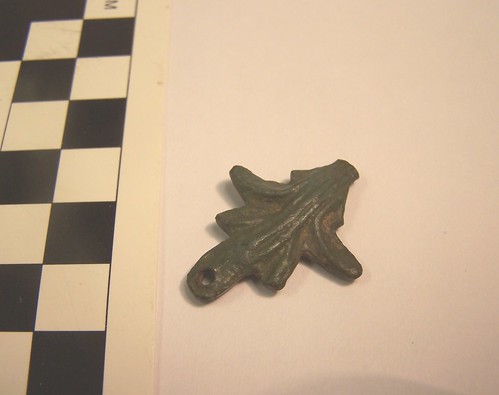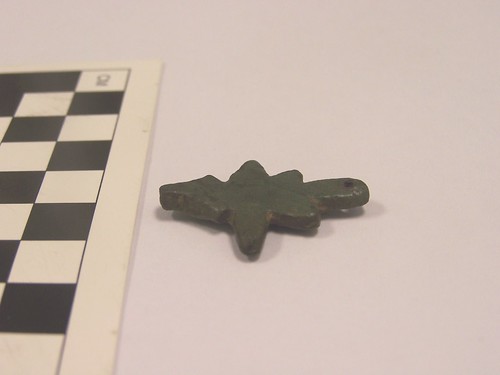Greetings all,
If any of you have the time, we’d appreciate your thoughts on the attached photo. This artifact was recovered during recent archaeological work near Fort Neoheroka (Tuscarora War - ca. 1713) in Greene County, North Carolina. It was located in the general vicinity of an allied Cherokee encampment/firing position as shown on a contemporaneous map.
The material is presumably copper alloy, although it doesn’t seem to be typical brass (possibly bronze). The form (acanthus leaf or flaming torch motif; possibly fleur-de-lis, but likely not) is similar to some of the French triggerguard finials that Hamilton [1980] illustrates from Fort Michilimackinac (Type C fusil, e.g., Figures 10k and 11c in his 1976 Michilimackinac report). We're not sure what to make of the hole, though; although the general opinion is that it could be a later modification for use as an ornament by the Cherokees, etc. Hamilton noted triggerguard fragments being utilized as ornaments (Hamilton 1979).
We’d appreciate any thoughts that any of you might have on this, both on age and function and on any more current references that might help with identification.
Thanks, all,
-Jess
First photo is of the artifact (it's upside-down in relation to the finials shown in Hamilton),
Link
Second photo is taken from Hamilton (1980:84) - triggerguard finials,
Link
Additional triggerguard finials may be seen here,
Link
If any of you have the time, we’d appreciate your thoughts on the attached photo. This artifact was recovered during recent archaeological work near Fort Neoheroka (Tuscarora War - ca. 1713) in Greene County, North Carolina. It was located in the general vicinity of an allied Cherokee encampment/firing position as shown on a contemporaneous map.
The material is presumably copper alloy, although it doesn’t seem to be typical brass (possibly bronze). The form (acanthus leaf or flaming torch motif; possibly fleur-de-lis, but likely not) is similar to some of the French triggerguard finials that Hamilton [1980] illustrates from Fort Michilimackinac (Type C fusil, e.g., Figures 10k and 11c in his 1976 Michilimackinac report). We're not sure what to make of the hole, though; although the general opinion is that it could be a later modification for use as an ornament by the Cherokees, etc. Hamilton noted triggerguard fragments being utilized as ornaments (Hamilton 1979).
We’d appreciate any thoughts that any of you might have on this, both on age and function and on any more current references that might help with identification.
Thanks, all,
-Jess
First photo is of the artifact (it's upside-down in relation to the finials shown in Hamilton),
Link
Second photo is taken from Hamilton (1980:84) - triggerguard finials,
Link
Additional triggerguard finials may be seen here,
Link








